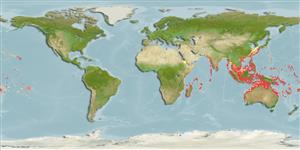Common names from other countries
Environment: milieu / climate zone / depth range / distribution range
Ecologia
; intervalo de profundidade 1 - 122 m (Ref. 4), usually 1 - 18 m (Ref. 4). Tropical, preferred 27°C (Ref. 107945); 36°N - 35°S, 33°E - 142°W (Ref. 4)
Indo-Pacific: South Africa to Japan and Polynesia.
Length at first maturity / Tamanho / Peso / Idade
Maturity: Lm ?, range 4 - ? cm Max length : 30.0 cm BL macho/indeterminado; (Ref. 4)
It has lengths of 30 cm, maximum total body length; 12 cm, maximum carapace length; 8 to 10 cm, average carapace length; 14 cm, total length of smallest ovigerous female (Ref. 4). Lives in clear or slightly turbid water at depths of 1 to 18 m (also reported from 122 m), in rocky areas and coral reefs. They are nocturnal and not gregarious (Ref. 4).
Life cycle and mating behavior
Maturidade | Reprodução | Desova | Ovos | Fecundidade | Larvas
Members of the order Decapoda are mostly gonochoric. Mating behavior: Precopulatory courtship ritual is common (through olfactory and tactile cues); usually indirect sperm transfer.
Holthuis, L.B. 1991. (Ref. 4)
Status na Lista Vermelha da IUCN (Ref. 130435)
Status no CITES (Ref. 108899)
Not Evaluated
Not Evaluated
Uso pelos humanos
Pescarias: espécies comerciais
FAO - pescarias: landings | FishSource | Sea Around Us
Ferramentas
Mais informação
Idade/TamanhoCrescimentoComprimento-pesoComprimento-comprimentoMorfologiaLarvasAbundância
Fontes da internet
Estimates based on models
Preferred temperature
(Ref.
115969): 24.7 - 29.3, mean 28.4 (based on 4141 cells).
Vulnerabilidade
Low vulnerability (20 of 100).
